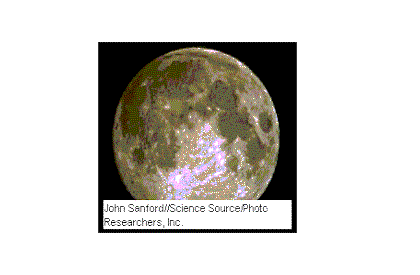
| The Sky | The Moon | The Sun | Eclipse | |
| Planets | Meteors | Asteroids | Comets | GroupMembers |

![]()
Moon, name given to the natural satellite of the earth, and sometimes applied to the satellites of the other planets in the solar system. The diameter of the earth’s moon is about 3480 km (about 2160 mi), or about one-fourth that of the earth, and the moon’s volume is about one-fiftieth that of the earth. The mass of the earth is 81 times greater than the mass of the moon. Thus the average density of the moon is only three-fifths, and the pull of gravity at the lunar surface only one-sixth, that of the earth . The moon has no liquid water and essentially no atmosphere, so no weather exists to change its surface; yet it is not totally inert.
The moon moves about the earth at an average distance of 384,403 km (238,857 mi), and at an average speed of 3700 km/h (2300 mph). It completes one revolution in an elliptical orbit about the earth in 27 days 7 hours 43 minutes 11.5 seconds with reference to the stars . For the moon to go from one phase to the next similar phase, or one lunar month, requires 29 days 12 hours 44 minutes 2.8 seconds. The moon rotates once on its axis in about the same period of time that elapses for its sidereal period of revolution, accounting for the fact that virtually the same portion of the moon is always turned toward the earth. Although the moon appears bright to the eye, it reflects into space only 7 percent of the light that falls on it. The reflectivity, or albedo, of 0.07 is similar to that of coal dust.
Surface of the Moon
Ancient observers of the moon believed that the dark regions on its face were oceans, giving rise to the name mare (Latin for "sea"), which is still used today; the brighter regions were likewise held to be continents. Modern observation and exploration of the moon has yielded far more comprehensive and specific knowledge. Since the Renaissance, telescopes have revealed a wealth of lunar detail, and lunar spacecraft have contributed further to this knowledge. Features discernible on the surface of the moon include craters, mountain ranges, plains or maria, faults, domes, rilles, and rays. The largest distinct crater, called Bailly, is 295 km (183 mi) wide and 3960 m (13,000 ft) deep. The largest mare or sea is Mare Imbrium (Sea of Rains), about 1200 km (about 750 mi) wide. The highest mountains, in the Leibnitz and Doerfel ranges near the south pole of the moon, have peaks up to 6100 m (20,000 ft) in height, comparable to the Himalayas on earth. Craters as small as 1.6 km (1 mi) across have been defined in telescopic observations. The origin of lunar craters has been long debated. The latest evidence indicates that nearly all craters were formed by explosive impacts of high-velocity meteorites or small asteroids, mostly during the early part of lunar history, when the solar system still contained many such fragments. Some craters, rilles, and domes, however, display characteristics of indisputable volcanic origin.
In 1996 a team working with data gathered by the United States Department of Defense Clementine spacecraft announced that frozen water may exist in a large basin near the moon’s south pole. Clementine’s radar showed what may be an 8000 sq km (3000 sq mi) area covered with a mixture of dirt and ice crystals. Clementine was launched in 1994 and gathered data for four months. More recent studies of the moon’s poles have not confirmed the team’s findings, but the U.S. National Aeronautics and Space Administration (NASA) plans to launch the Lunar Prospector spacecraft in late 1997 to take a closer look at the moon.
The Moon's Position in the Sky
The Orbit of the Moon
